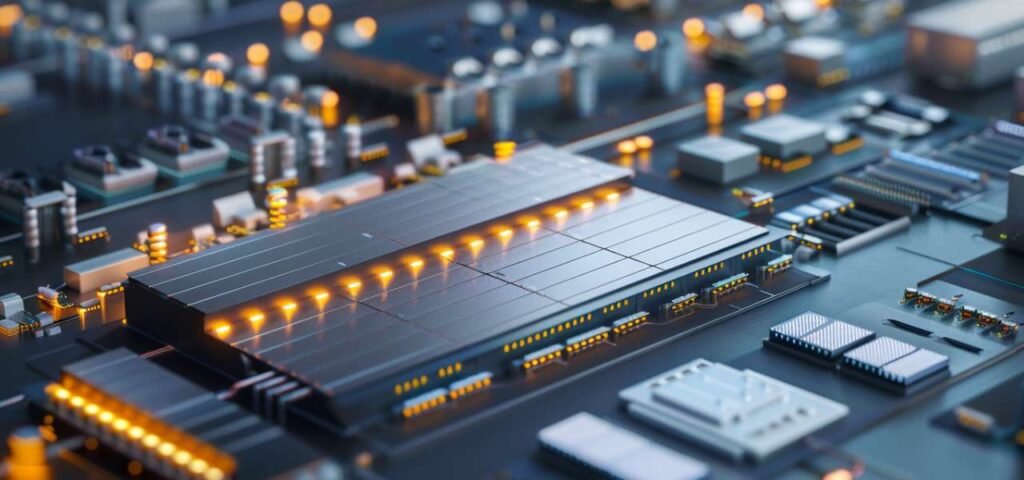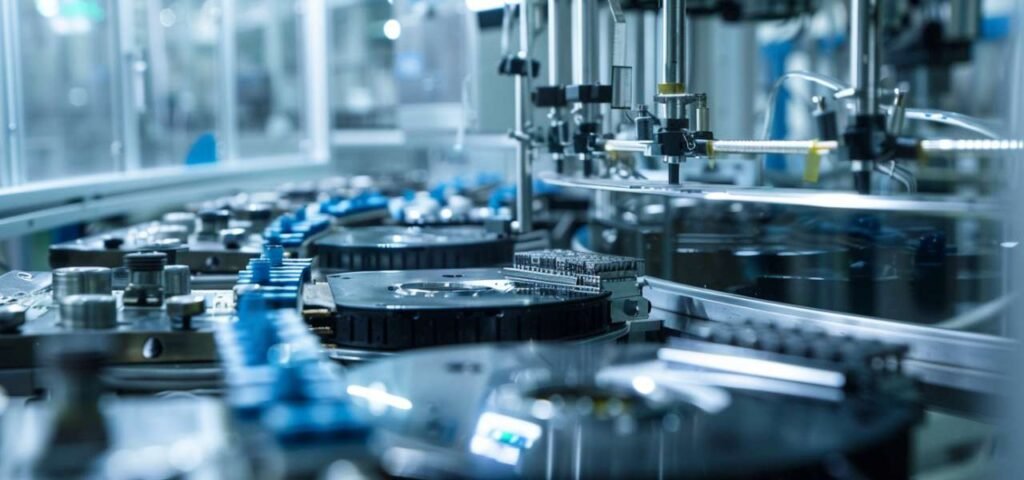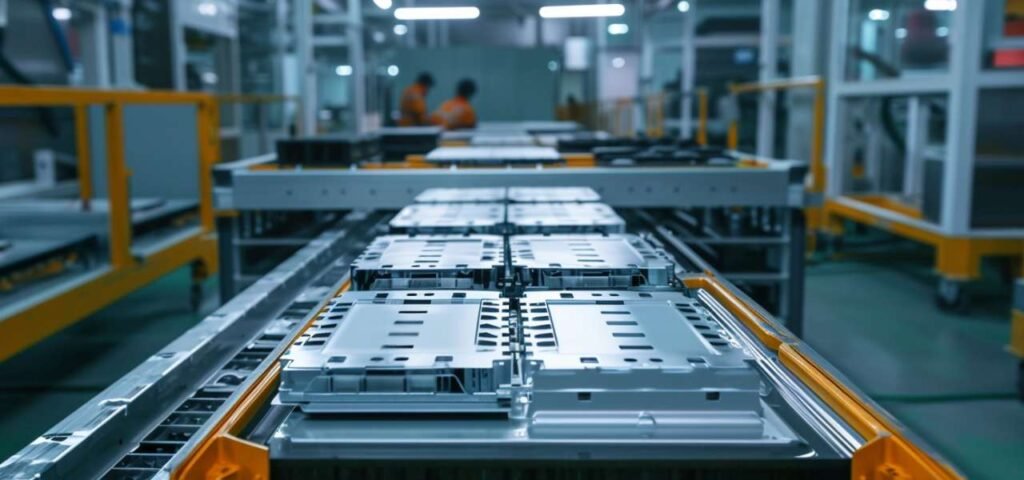1.What is the Design of Lithium-ion Battery Cells?
The design of lithium-ion battery cells refers to a method of assembling positive electrode materials, negative electrode materials, electrolytes, separators, and positive and negative current collectors in certain proportions and processes to meet the requirements of certain electrical performance. Designers are required to understand the characteristics of positive electrode materials, negative electrode materials, electrolytes, separators, and conductive agents, as well as possess rich knowledge of electrochemistry and have a holistic thinking logic. This is a vast manufacturing engineering project that involves multiple processes, each with its own technological characteristics.
2.Clear Objectives for Lithium-ion Battery Cell Design
First, it is essential to clarify the requirements that the cell design needs to meet. Currently, the demand for battery cells mainly comes from two aspects: one is the internal technical storage of battery companies, anticipating market demand in advance; the other is from companies requiring battery cells, whether for consumer batteries or power batteries, needing to translate enterprise requirements into the language of battery cells.

3.Basics of Lithium-ion Battery Cell Design
The fundamental principle of cell design is to find a relative balance point among parameters such as energy density, lifespan, rate capability, and cost because different indicators are difficult to satisfy simultaneously. Therefore, it is crucial to classify goals according to customer demands:
(1) Requirements that must be met by customers, such as capacity, energy, safety, etc.;
(2) Special requirements of customers should be met as much as possible, such as fast charging, power, etc.;
(3) Non-essential customer requirements. Identifying these requires multiple and in-depth communications with customers to avoid design deviations.
4.Selection of Materials for Lithium-ion Battery Cell Composition
Selection of Positive Electrodes:
The choice of positive electrode material determines the energy density of the cell. Ternary materials and lithium iron phosphate are the most commonly used positive electrode materials in power battery cells, while lithium cobalt oxide is more common in consumer battery cells. Whether it is a consumer or power battery, the basic design concepts are essentially the same. Taking square power battery cells as an example, if our design goal is to achieve 210 Wh/kg, then ternary materials of 5 series or above are normally required; to achieve over 240 Wh/kg, ternary materials of 8 series or above are needed. Currently, there is a disagreement within the industry regarding the use of 8 series materials. Therefore, a different approach is needed when choosing positive electrode materials. We all know that energy density is mainly determined by capacity (C) and voltage (V). When it is not possible to choose high-capacity materials, we must increase the cutoff voltage of the material, such as from 4.2 V to 4.35 V. Additionally, if the increase in capacity and voltage still cannot fully meet the requirements of energy density, further optimization of the cell’s structure and processes is required.
Selection of Negative Electrodes:
Negative electrode materials are mostly artificial graphite, which can also be doped with silicon, or use lithium titanate, hard carbon, etc. For artificial graphite paired with ternary materials, its specific capacity has basically reached around 350 mAh/g. For predetermined cell cases, increasing the specific capacity of the negative electrode can reduce the amount of negative electrode material used, thereby increasing the energy density of the cell. Among these, doping silicon into graphite electrodes is a relatively effective method, but doping silicon will cause the negative electrode to expand, reducing initial efficiency and posing challenges to fast charging capability and cycle life. Therefore, when deciding to add silicon, the amount of doping and subsequent lithium replenishment processes need to be considered simultaneously.
Selection of Separators:
The selection of separators needs to consider not only their material, thickness, and cost but also porosity, permeability, ceramic coating weight, and whether PVDF coating is applied. Ceramic coating can improve the safety performance of the battery cell, while PVDF coating can optimize the fit of the cell interface. However, these coatings also bring about increased costs and process complexities, which designers need to carefully consider according to requirements.
Selection of Electrolytes:
The electrolyte acts as an ion conductor and electronic insulator between the positive and negative electrodes of the battery. In secondary lithium-ion batteries, the properties of the electrolyte have a significant impact on the battery’s cycle life, operating temperature range, charge and discharge efficiency, safety, and power density. Secondary lithium electrolyte materials should have the following properties: (1) high lithium ion conductivity; (2) high electrochemical stability, maintaining stability over a wide potential range; (3) good compatibility with electrodes, forming a stable SEI film on the negative electrode and having sufficient antioxidation decomposition ability on the positive electrode under high potential conditions; (4) good contact with the electrodes, for liquid electrolytes, able to fully wet the electrodes; (5) good low-temperature performance, maintaining high conductivity and low viscosity in a lower temperature range (-20~20 ℃) to maintain good electrode surface wetting during charge and discharge processes; (6) wide voltage range; (7) good thermal stability, no thermal decomposition over a wide temperature range; (8) good chemical stability, no chemical reactions with positive and negative electrodes, current collectors, binders, conductive agents, separators, packaging materials, sealants, etc., during long-term battery cycling and storage processes; (9) non-toxic, non-polluting, safe to use, preferably biodegradable; (10) easy to prepare, low cost. Currently, electrolyte additives mainly include SO2/CO2/VC (vinyl carbonate) [to improve SEI film performance], trimethyl phosphate (TMP) [to improve electrolyte safety], crown ether [to increase electrolyte conductivity], Al2O2, MgO, lithium or calcium carbonate [to control water and acid content]. Therefore, appropriate electrolytes need to be selected based on the performance achievable by the battery cell.

Selection of Current Collectors:
The current collector is an indispensable component in lithium-ion batteries. It not only carries the active material but also collects and outputs the current generated by the electrode’s active material, which helps to reduce the internal resistance of lithium-ion batteries and improve their coulombic efficiency, cycling stability, and rate performance. In principle, the ideal current collector for lithium-ion batteries should meet several conditions: (1) high electrical conductivity; (2) good chemical and electrochemical stability; (3) high mechanical strength; (4) good compatibility and adhesion with the electrode’s active material; (5) affordability and availability; (6) lightweight. However, in practical applications, different current collector materials still have various issues, making it challenging to fully meet the multi-scale requirements mentioned above. For example, copper is prone to oxidation at higher potentials, making it suitable for use as a current collector for negative electrode materials such as graphite, silicon, tin, and cobalt-tin alloys. On the other hand, aluminum, as a current collector for the negative electrode, faces severe corrosion issues but is suitable for use as a current collector for the positive electrode.
Currently, materials that can be used as current collectors for lithium-ion batteries include metals such as copper, aluminum, nickel, and stainless steel, semiconductor materials such as carbon, and composite materials.
A. Copper Current Collectors
Copper is an excellent metal conductor with electrical conductivity second only to silver. It has many advantages such as abundant resources, affordability, and good ductility. However, considering that copper is prone to oxidation at higher potentials, it is commonly used as a current collector for negative electrode active materials such as graphite, silicon, tin, and cobalt-tin alloys. Common copper current collectors include copper foil, copper foam, copper mesh, and three-dimensional nano-copper array current collectors.
(1) Copper foil current collectors. Copper foil can be further divided into rolled copper foil and electrolytic copper foil based on the production process. Compared with electrolytic copper foil, rolled copper foil has higher electrical conductivity and better ductility, making it suitable for lithium-ion batteries with low bending requirements to choose electrolytic copper foil as the negative electrode current collector. Studies have shown that increasing the roughness of the copper foil surface is conducive to improving the bonding strength between the current collector and the active material, reducing the contact resistance between the active material and the current collector, and correspondingly improving the rate discharge performance and cycling stability of the battery.
(2) Copper foam current collectors. Copper foam is a three-dimensional porous material similar to a sponge, which has many advantages such as lightweight, high strength and toughness, and large specific surface area. Although silicon and tin negative electrode active materials have high theoretical specific capacities and are considered to be promising negative electrode active materials for lithium-ion batteries, they also have disadvantages such as large volume changes and pulverization during cycling, which severely affect battery performance. Studies have shown that copper foam current collectors can suppress the volume changes of silicon and tin negative electrode active materials during charge and discharge processes, thereby slowing down their pulverization phenomenon and improving battery performance.
B. Aluminum Current Collectors
Although aluminum has lower conductivity than copper, when transporting the same amount of electricity, the mass of aluminum wire is only half that of copper wire. Undoubtedly, using aluminum current collectors helps to increase the energy density of lithium-ion batteries. In addition, compared with copper, aluminum is more affordable. During the charge/discharge process of lithium-ion batteries, the surface of aluminum foil current collectors forms a dense oxide film, which enhances the corrosion resistance of aluminum foil. Therefore, aluminum foil is commonly used as a current collector for the positive electrode in lithium-ion batteries. Similar to copper foil current collectors, surface treatment can also improve the surface characteristics of aluminum foil. After DC etching, the surface of the aluminum foil forms a honeycomb-like structure, which is more closely combined with the positive electrode active material and improves the electrochemical performance of lithium-ion batteries. However, in practice, aluminum current collectors often corrode severely due to the destruction of the passive film on the surface, leading to a decrease in battery performance. Therefore, to improve the corrosion resistance of etched aluminum foil, its surface needs to be optimally treated to form a more stable passive film.
C. Nickel Current Collectors
Relatively speaking, nickel is a relatively inexpensive metal with good conductivity and stability in acidic and alkaline solutions. Therefore, nickel can be used as both a positive electrode and a negative electrode current collector. Matching with it are positive electrode active materials such as lithium iron phosphate and negative electrode active materials such as nickel oxide, sulfur, and carbon-silicon composites. The shape of nickel current collectors usually includes nickel foam and nickel foil. Due to the developed pores of nickel foam, the contact area with the active material is large, thereby reducing the contact resistance between the active material and the current collector. When using nickel foil as an electrode current collector, with the increase of charge/discharge cycles, the active material is prone to detach, affecting battery performance. Similarly, surface pretreatment processes are also applicable to nickel foil current collectors. For example, after etching the surface of the nickel foil, the bonding strength between the active material and the current collector is significantly enhanced. Nickel oxide has the advantages of structural stability and low cost, and has a high theoretical specific capacity. It is a widely used negative electrode active material for lithium-ion batteries. Based on this, by in situ growing a layer of nickel oxide on the surface of nickel foam using a solid-phase oxidation method, a nickel oxide negative electrode with nickel foam as the current collector is prepared. Compared with nickel foil/nickel oxide electrodes, the first discharge specific capacity of nickel foam/nickel oxide electrodes significantly increases. This is because the three-dimensional structure of the current collector reduces the interfacial polarization phenomenon and improves the charge/discharge cycling stability of the battery. Lithium iron phosphate is considered an ideal positive electrode active material for power lithium-ion batteries due to its advantages of good safety and wide availability of raw materials. Coating lithium iron phosphate on the surface of nickel foam current collectors can increase the contact area between LiFePO4 and nickel foam, reduce the current density of interface reactions, and improve the rate discharge performance of LiFePO4.
D. Stainless Steel Current Collectors
Stainless steel refers to an alloy steel containing elements such as nickel, molybdenum, titanium, niobium, copper, and iron. It has good conductivity and stability, can resist corrosion from weak corrosive media such as air, steam, and water, and can resist chemical erosion from strong corrosive media such as acids, alkalis, and salts. Stainless steel surfaces also easily form a passive film to protect against corrosion. Additionally, stainless steel can be processed thinner than copper, making it cost-effective, simple in production, and suitable for mass production. Stainless steel can be used as both positive and negative electrode current collectors, and common stainless steel current collectors include stainless steel mesh and porous stainless steel.
(1) Stainless steel mesh current collectors. Stainless steel mesh is dense in texture. When used as a current collector, its surface is wrapped by the electrode’s active material and does not directly contact the electrolyte, making it less prone to side reactions and conducive to improving battery cycling performance.
(2) Porous stainless steel current collectors. To fully utilize the active material and increase the discharge specific capacity of the electrode, a simple and effective method is to use porous current collectors.
E. Carbon Current Collectors
When carbon materials are used as positive or negative electrode current collectors, it can avoid the corrosion of electrolyte on metal current collectors. Carbon materials have advantages such as abundant resources, easy processing, low electrical resistivity, environmental friendliness, and low cost. Carbon fiber cloth, with its good flexibility, conductivity, and electrochemical stability, can be used as the current collector for flexible lithium-ion batteries. Carbon nanotubes are another form of carbon current collector. Compared with metal current collectors, their significant advantage is lightweight, and they can significantly increase the energy density of batteries.
F. Composite Current Collectors
In addition to single current collectors such as copper, aluminum, nickel, stainless steel, and carbon, composite current collectors have also attracted the attention of scholars in recent years, such as conductive resin, carbon-coated aluminum foil, and titanium-nickel shape memory alloys.
G. Conductive Resin Current Collectors
Polyethylene (PE) and phenolic resin (PF) current collectors are composed of conductive fillers and polymer resin matrices. Using PE and PF as the matrix materials, and uniformly mixing them with conductive fillers such as graphite and carbon black, composite current collectors are prepared, and their physicochemical properties are studied. Graphene is a unique two-dimensional carbon functional material formed by carbon atoms through sp2 hybridization, with ultra-high electrical conductivity, specific surface area, and mechanical strength. It can replace graphite as the negative electrode active material of lithium-ion batteries and can also be used as a current collector material.
H. Titanium-Nickel Shape Memory Alloy Current Collectors
Titanium-nickel shape memory alloys are binary alloys composed of nickel and titanium. They can transform between two different crystal phases with changes in external temperature or pressure. Titanium-nickel shape memory alloys can suppress the volume changes of active materials during charge and discharge processes by changing their own phase state, thereby improving the battery’s cycle life.
I. Carbon-Coated Aluminum Foil Current Collectors
Carbon-coated/aluminum foil current collectors are composite current collectors with a carbon composite layer coated on the surface of aluminum foil. The carbon layer is composed of carbon fibers and carbon black particles treated with dispersants, which can tightly combine with aluminum foil, thereby improving the electrical conductivity and corrosion resistance of the electrode.
Current collectors are one of the indispensable components in lithium-ion batteries, with multiple functions of carrying electrode active materials and collecting output currents. Current collectors made from different materials and production processes have their own advantages and disadvantages, and they have different effects on lithium-ion batteries.

5.Design of Lithium-ion Battery Cell Capacity
The simple formula for calculating cell capacity is as follows:
Design capacity = Gram capacity of positive electrode material * Coating weight * Loading * Electrode length * Electrode width * 2 * Number of windings
The gram capacity of positive electrode material is provided by the material manufacturer when it leaves the factory. Of course, battery manufacturers will also conduct their own tests to ensure batch stability, thereby improving the consistency of subsequent assembly. The typical testing method involves using button cells with lithium electrodes. The coating weight is measured in g/m2, and coating methods include transfer coating and extrusion coating. Due to the advantages of extrusion coating in tolerance and precision, most production lines currently use extrusion coating. Loading refers to the proportion of active material mass in the positive electrode formulation. For rectangular cell production, the number of winding cores is usually 2 or 4. Fewer manufacturers choose to use 1 winding core due to potential issues such as longer electrode lengths leading to difficulties in die-cutting, which can affect yield, and difficulties in controlling misalignment with too many layers.
6.Design of N/P Ratio for Lithium-ion Battery Cells
The N/P ratio is calculated as follows:
N/P = Gram capacity of negative electrode * Mass of negative electrode active material / Gram capacity of positive electrode * Mass of positive electrode active material. The main purpose is to ensure that the lithium insertion capacity of the negative electrode at the same time and location is greater than the lithium removal capacity of the positive electrode. Gram capacities are generally obtained from discharge testing, so there are typically two N/P ratios: one for initial charging and one for subsequent discharging. The design of the N/P ratio for initial charging is mainly to ensure that lithium stripping does not occur during the formation stage. The design of the N/P ratio for subsequent discharging is mainly to ensure long-term cycling performance. Therefore, the actual selection of the N/P value needs to consider both charging and discharging to make the optimal choice.
7.Safety Design of Lithium-ion Battery Cells
Safety is a key consideration in the internal design of battery cells. General strategies include:
(1) Overhang design: This involves ensuring that the separator’s length and width can cover the negative electrode, and the negative electrode’s length and width can cover the positive electrode. This approach has several benefits: it prevents internal short circuits caused by electrode expansion during charging and discharging, and it prevents the separator from being pressed down, which could cause internal short circuits.
(2) Ceramic coating on the positive electrode edge: This refers to applying a layer of insulating ceramic on the edge of the positive electrode to prevent short circuits between the positive and negative electrodes.
(3) Top cover safety design: This mainly includes fuse protection and overcharge shutdown (OSD) flip design. Design considerations include the fuse’s overcurrent capability, which requires collecting and testing relevant validation data for both continuous and peak currents. OSD is primarily used to prevent overcharging. As mentioned in a previous article, with the release of new national standards, ternary systems can pass overcharge tests without OSD. Therefore, to improve the reliability and reduce the cost of top covers, OSD may gradually be phased out.
8.Formulation Design of Positive and Negative Electrodes for Lithium-ion Battery Cells
The formulation of the positive electrode typically consists of ternary materials, conductive agents, binders, etc., with NMP as the solvent. Common conductive agents include SP, KS-6, and CNT, while binders are often PVDF. To maximize cell energy density, the loading of NCM should be at least 95%, but not 100% due to the importance of auxiliary materials. The roles of conductive agents and binders are self-explanatory. SP is a linear conductive agent that provides long-range conductivity, while KS-6 is a flaky conductive agent that provides short-range conductivity. In practical applications, both are used together to improve conductivity.
The formulation of the negative electrode is similar, consisting mainly of graphite/silicon, conductive agents, binders, emulsifiers, etc., with the main material content also aiming for over 96%. The types of conductive agents are similar to those in the positive electrode, but binders and emulsifiers differ. Binders commonly include SBR (styrene-butadiene rubber) and acrylic materials, which not only improve adhesion but also accelerate lithium ion transport. The solvent for graphite negative electrode slurry is often deionized water. Since graphite is a non-polar material with low surface energy, while water is a polar solvent, the emulsifier CMC-Na (carboxymethyl cellulose sodium) forms hydrophobic bonds with graphite surfaces via van der Waals forces, while hydrophilic groups bind with water to enhance graphite’s hydrophilic properties. Additionally, after encapsulating CMC-Na, the negative charge on the graphite surface increases, leading to stronger repulsion between particles and less sedimentation in the slurry. Therefore, CMC-Na plays a dual role in enhancing graphite hydrophilicity and providing spatial resistance.

